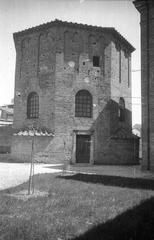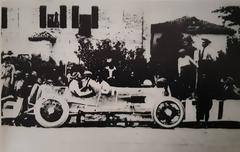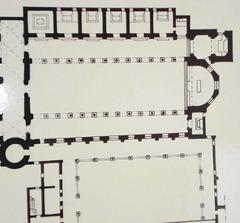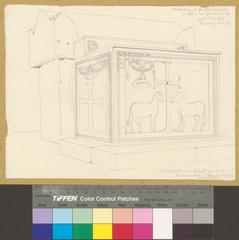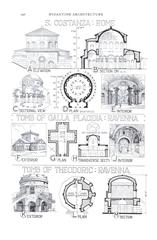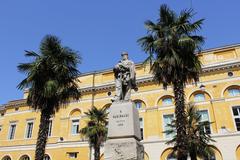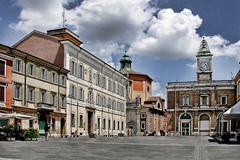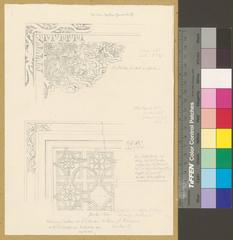Casa Capra Ravenna, Italy: Visiting Hours, Tickets, and Historical Significance
Date: 14/06/2025
Introduction
Nestled in the pedestrian-friendly heart of Ravenna, Italy, Casa Capra stands as a compelling testament to the city’s Baroque-era residential architecture. While Ravenna is famed for its UNESCO-listed Early Christian and Byzantine monuments, Casa Capra offers visitors a unique window into the world of noble families that shaped the city’s identity beyond its mosaics. Built in 1637 for Donato Capra, a distinguished canon and doctor, the residence exemplifies the city’s layered history, blending architectural sophistication with enduring civic legacy (Edifici Storici Ravenna; Wikipedia: Ravenna).
This comprehensive guide presents the historical context, architectural features, cultural significance, practical visitor information, and tips for exploring Casa Capra and its surroundings.
Historical and Cultural Context
Ravenna: A City of Empires
Ravenna, in the Emilia-Romagna region, has been a crossroads of civilizations—Roman, Ostrogothic, Byzantine, and Renaissance. Its prominence as the Western Roman Empire’s final capital and the Byzantine Exarchate’s seat left an indelible mark on its architecture and culture (Wikipedia: Ravenna). While its mosaics attract global admiration, the city’s urban fabric also tells stories of noble families, such as the Capras, who contributed to its social and cultural evolution.
The Capra Family and Casa Capra
The Capra family, whose name means “goat” in Italian, rose to prominence during the Renaissance, becoming influential landowners and civic leaders. Their residence, Casa Capra, reflects their status and taste, blending Baroque elegance with local traditions. The house’s monumental entrance, bearing the Capra coat of arms—a white goat on a red field—asserts the family’s identity and enduring legacy (Edifici Storici Ravenna).
Cultural Significance
Casa Capra’s value lies not only in its architecture but also in its representation of Ravenna’s patrician life beyond religious and imperial monuments. It forms part of the city’s intricate network of historic homes, each contributing to the narrative of urban development, social hierarchy, and artistic patronage (Visit Ravenna; Full Suitcase).
Architectural Features
Exterior Highlights
- Facade: Exposed brickwork combined with a robust Istrian stone plinth (zoccolatura) exemplifies refined Baroque-era design.
- Entrance Portal: The main doorway, crafted from Istrian stone and dated “1637,” is adorned with the Capra family’s heraldic goat, a striking symbol of status (Notaiomonticelli Cuggio).
- Historic Layers: Remnants of an ancient arch between ground-floor windows suggest previous structures, reflecting Ravenna’s practice of architectural adaptation (Edifici Storici Ravenna).
Interior Highlights
- Atrium: Behind the portal, visitors find a raised hall with arched roofing and stone corbels, historically serving as a semi-public space for receiving guests.
- Adaptive Reuse: Today, Casa Capra houses professional offices, demonstrating the balance between preservation and modern function (Notaiomonticelli Cuggio).
Artistic Value
Casa Capra’s design demonstrates the blending of Baroque influences with Ravenna’s regional preferences for material and proportion. The heraldic portal remains a focal point for both artistic appreciation and family legacy (Edifici Storici Ravenna).
Visitor Information
Location
- Address: Via Antonio Zirardini, Ravenna, within the historic city center.
- Proximity: Steps from the Basilica di San Vitale, Mausoleum of Galla Placidia, and Piazza del Popolo (Velvet Escape).
Visiting Hours
- General Access: Casa Capra is primarily appreciated from the exterior. There are no set public visiting hours for the interior, as it is a private building currently used for offices.
- Guided Tours: The building is included in heritage walking tours organized by local associations and may occasionally open for cultural events (Edifici Storici Ravenna; Visit Ravenna).
Tickets
- Exterior Viewing: Free.
- Guided Tours: May require a fee; book in advance via the Ravenna tourist office or official websites.
Accessibility
- Historic Limitations: The building’s age and structure restrict full accessibility, though the area is flat and suitable for walking. Contact tour organizers for specific needs.
Getting There
- By Train: Ravenna’s central station is a 10–15 minute walk from Casa Capra.
- By Car: Limited parking in the center; public lots are nearby. Walking and biking are the best ways to explore.
- By Bus: City buses connect the main station, outskirts, and city center (hikersbay.com).
Nearby Amenities
- Dining: Numerous cafés and trattorias in Via Cavour and Piazza del Popolo offer local cuisine like piadina and squacquerone.
- Shopping: Artisan shops and mosaic studios are within walking distance for authentic souvenirs (Velvet Escape).
- Restrooms & Info: Public facilities and tourist information points are distributed throughout the historic center.
Best Time to Visit
- Climate: Mild spring (April–May) and fall (September–October) offer ideal sightseeing weather (Weather25).
- Crowds: Ravenna is less crowded than Italy’s major tourist hubs, providing a relaxed atmosphere year-round.
Tips for a Memorable Visit
- Combine Experiences: Integrate Casa Capra into a walking tour of Ravenna’s UNESCO sites, mosaic workshops, and local trattorias.
- Photography: The facade is especially photogenic in early morning or late afternoon light.
- Respect Privacy: As a private residence, refrain from entering unless part of an authorized tour.
- Guided Insights: Join a local tour for in-depth historical context.
- Maps & Resources: Obtain free city maps at the tourist office or download digital guides (thetravelfolk.com).
Frequently Asked Questions (FAQ)
Q: Can I visit the inside of Casa Capra?
A: No, the interior is not regularly open to the public. Exterior viewing is always possible; interior visits may occur during special events or tours.
Q: Are tickets required?
A: No tickets are needed to view the exterior. Guided tours that include Casa Capra may charge a fee.
Q: Is Casa Capra accessible for wheelchairs?
A: The area is generally accessible, but the building itself has historic limitations.
Q: Are guided tours available?
A: Yes, local organizations and tourism operators include Casa Capra in heritage walks.
Q: Can I take photographs?
A: Yes, photography is allowed from public areas outside the building.
Accommodation Near Casa Capra
Stay in the heart of Ravenna at Palazzo Galletti Abbiosi, Casa Masoli, or Casa Gugù, offering easy access to Casa Capra and other attractions (thetravelfolk.com). Advance booking is recommended during peak seasons.
Visuals and Media
Include high-resolution photos of Casa Capra’s facade and architectural details with descriptive alt text (“Casa Capra facade in Ravenna”). Use interactive maps and, where possible, provide links to virtual tours for enhanced engagement.
Summary and Recommendations
Casa Capra enriches Ravenna’s historical tapestry, illustrating the city’s evolution from imperial and ecclesiastical grandeur to the refined lifestyles of its patrician families. Its Baroque features and heraldic symbolism offer a nuanced perspective on Ravenna’s architectural diversity and the Capra family’s legacy. While not as internationally renowned as the city’s basilicas, Casa Capra is an essential stop for those seeking to understand Ravenna’s full historical spectrum.
To maximize your experience:
- Combine Casa Capra with UNESCO sites and local culinary stops.
- Use guided tours for deeper insight.
- Stay updated on special events and opening information via official tourism channels or the Audiala app.
References
- Wikipedia: Ravenna
- Edifici Storici Ravenna
- Notaiomonticelli Cuggio
- Visit Ravenna
- Velvet Escape
- Full Suitcase: Ravenna Best Things to Do
- ScienceDirect: Heritage Spatial Perceptions
- thetravelfolk.com
- Weather25
- hikersbay.com
- mapcarta.com
- savoringitaly.com
For additional updates, virtual tours, and personalized travel tips, download the Audiala app or check official Ravenna tourism resources.
